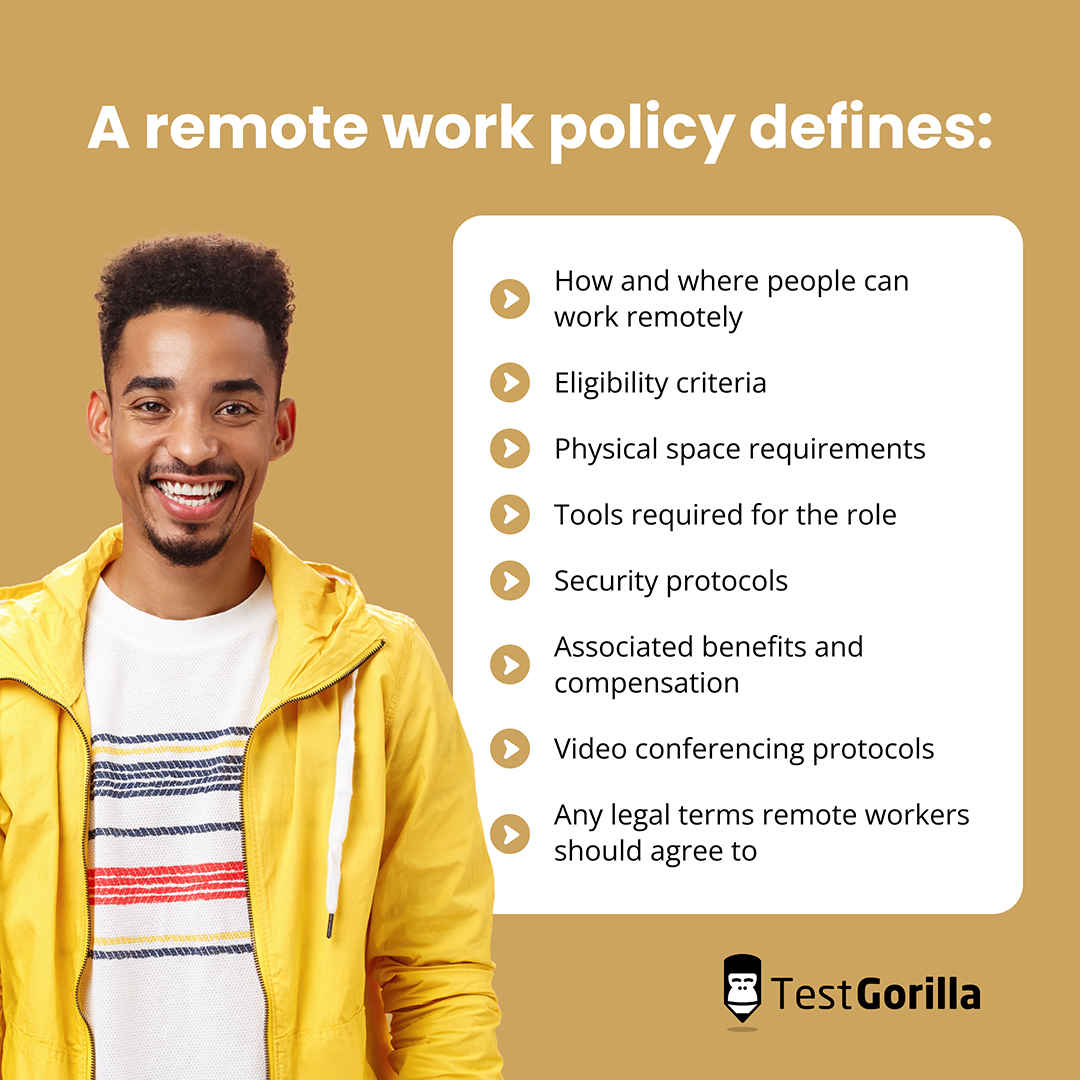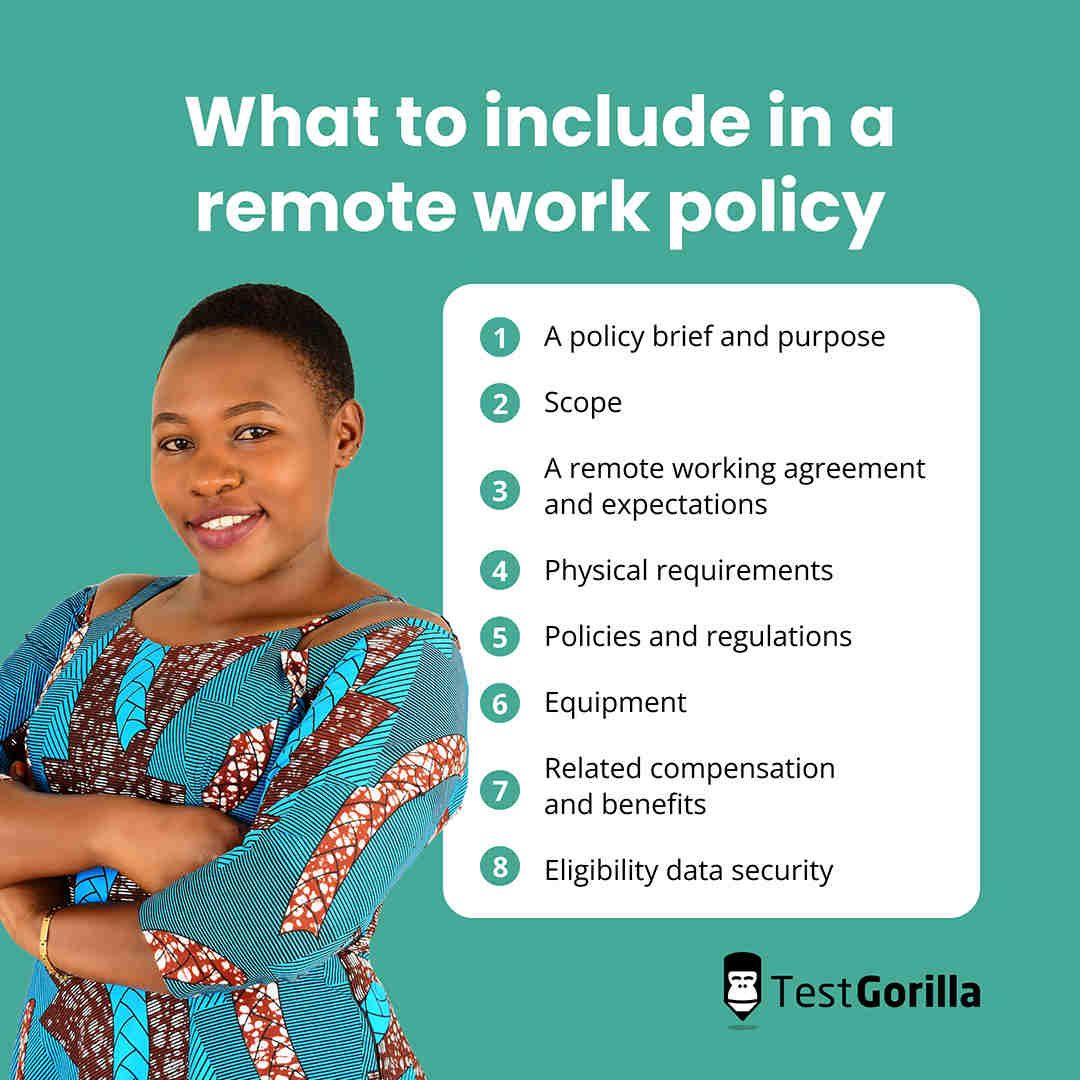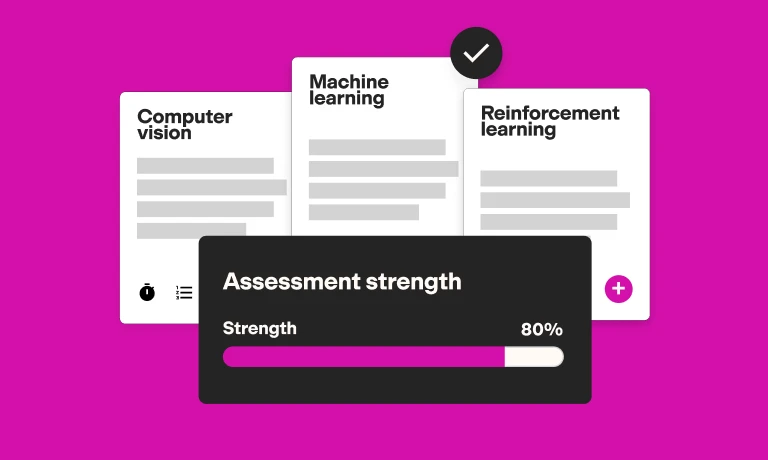Remote work policy: How to leverage this talent retention trend and inspire offsite employees
People are working remotely more than ever, with 87% of people seizing remote opportunities.[1]
It's an attractive perk for recruits and an even stronger talent retention trend. Around 38% of people would even take a 5% pay cut in return for some offsite projects.[2]
It’s worth hopping on this trend, but you need an effective remote work policy to protect everyone’s interests or risk:
Remote security issues
A slow and disorganized onboarding process
Employee confusion
Unchecked compliance
A remote work policy helps you communicate clearly and ensure everyone has fair access to remote working and that your staff knows their limits.
Below, we reveal what to include in a remote work policy and how to manage it effectively to retain top talent.
Table of contents
- What is a remote work policy?
- Why are remote work policies important?
- The benefits of a remote work policy
- A remote work policy template: What to include
- 8 best practices for leveraging remote work policies to retain your best performers
- Remote work policy: 3 examples of companies succeeding with this talent retention trend
- Create a remote working policy and get the best out of offsite talent
What is a remote work policy?
A remote work policy gives employees clear guidelines to follow when working offsite. Remote workers should agree to these guidelines in addition to standard policies.
A remote work policy defines:
How and where people can work remotely
Eligibility criteria
Physical space requirements
Tools required for the role
Security protocols
Associated benefits and compensation
Video conferencing protocols
Any legal terms remote workers should agree to
When you lay out remote work guidelines, you support people who want to work offsite and protect your business.
Remote policies help strengthen proven talent retention strategies, too. For example, adding remote work FAQs to a robust employee onboarding plan could boost recruits’ confidence as they settle into their roles.
Why are remote work policies important?
For remote work to remain fair, measurable, and desirable, companies need policies to provide clarity and confidence.
That’s clarity and confidence for employers as well as their workers.
For example, up to 72% of employers are at least somewhat concerned about the security risks remote working could bring. IBM research suggests remote work can increase the cost of a cyberattack by more than $173,000 on average.
Security risks are a reason why some companies avoid offering remote work altogether.
A remote work policy alleviates these concerns by informing employees and agents how to manage their data and systems safely.
Remote policies help streamline the onboarding process for remote workers, too. With a template, human resources can follow the same policy for each recruit without making adjustments.
This further benefits recruits who might not know what to expect. It's reassurance that an employer controls the situation and has the tools and resources to support remote work effectively.
Another sticking point for some employers during the remote working boom has been the temptation to micromanage. Up to 65% of managers don't trust their teams to work remotely at all.
Instead, a remote policy ensures workers know how to be productive offsite, what their responsibilities are, and what you expect from them.
Moreover, employees can rely on remote policies to help open up opportunities across the company. As part of an inclusive culture, HR can make eligibility for remote work open and fair, setting clear criteria rather than offering it as an exclusive perk.
The best insights on HR and recruitment, delivered to your inbox.
Biweekly updates. No spam. Unsubscribe any time.
The benefits of a remote work policy
When you implement a remote work policy effectively:
There’s more clarity
Remote work is consistent and fair
It’s faster to onboard remote employees
Your employee retention rate increases
Let’s explore how and why.
1. There’s more clarity.
Role clarity is as important for remote staff as it is for in-house employees. Up to 58% of employees simply want to do what they do best, which means they need clear expectations.
Workers with clear roles and responsibilities are up to 84% more likely to stay with a company, and that goes for your offsite teams as much as your office personnel.[3]
Remote working policies include:
Where people can legally work, e.g., if they can cross state lines
What software staff can use to communicate with others
What employee benefits are available for remote staff
How workers can keep data safe
Who they can contact out of office hours
Building a policy also helps ensure compliance. Research from Deloitte suggests 30% of companies have yet to establish policy guardrails – and that “policies and regulation” is the top blockade for remote work:
2. Remote work is consistent and fair.
Without a remote work policy, there’s no clear eligibility or system of checks to decide who can and can’t take part.
A policy ensures consistency and prevents unconscious bias from affecting decision-making over who gets to work remotely.
Ideally, a remote policy's eligibility should revolve around specific roles and whether or not they're adaptable offsite, not around individual traits.
Research shows more than 70 million workers across the US could work remotely – which tells us that there are already ample opportunities people are missing out on and that companies could do more to boost inclusivity for them.[4]
3. It’s faster to onboard remote employees.
Remote or virtual onboarding timescales vary and depend entirely on the job role. In some cases, bringing remote workers onboard could take up to three months.[5]
One way to ensure remote onboarding is as efficient as possible is to cement what recruits can expect via a clear remote policy.
The more clearly defined the process, the less time it takes for recruits to adapt. The faster you onboard people this way, the more remote employees you can get up to speed in a given timeframe.
4. Your employee retention rate increases.
Remote working is now such an important driver for employer retention rates that around half of all workers look for alternative employment if their company removes their ability to work remotely.
This means that a company that fails to offer a consistent, fair remote work policy could risk losing talent to rival firms with a more robust system in place.
Even pre-pandemic, research showed that employee turnover rates were 25% lower for companies with remote work support. Given the boom in remote working since COVID-19, more people than ever now see it as an important benefit.[6]
That said, a remote working arrangement needs a clear, airtight policy to keep talent engaged with a company.
A remote work policy template: What to include
There are a few key points to include in your remote work policy employee handbook. Let’s explore them in detail.
1. A policy brief and purpose
Explain to remote work employees why your policy brief is in place, and establish whether it is temporary or permanent.
For example, you could explain that the agreement covers a temporary period when an employee relocates to a different office cross-country.
Or you might be laying out the conditions for working remotely while on workation.
Regardless of your reasons, you’re improving the employee experience because your intentions and expectations are out in the open.
2. Scope
Tell staff to whom the policy applies and to what extent.
For instance, you might build a policy purely for contingent workers, people with accessibility needs, or specific teams and roles.
Explain your scope flexibility and ensure workers know what they can do to become eligible, if applicable.
In some cases, you might require people to work a specific number of hours or on a particular team to be eligible.
3. A remote working agreement and expectations
Lay out your base expectations for remote workers and what conditions of employment they need to agree to before getting started.
In your agreement, establish:
When and where remote employees can work
Whether or not they need to attend the office at any time
Which circumstances can extend remote work arrangements, e.g., parental leave
Who remote agents can contact should they need to extend their arrangements
Who employees can contact for technical support or work queries
Their job duties while remote
Any communication channels required
Whether or not staff can choose their working hours
When you expect workers to check in and report to managers
Details for remote employee training program opportunities
Social events that might require in-person attendance
Your international remote work policy
This list isn't exhaustive but should give you a clear idea of what remote employees need to know.
Show that you adhere to labor standards. For hourly employees, ask that remote workers “clock” in and out of shifts to ensure they work the hours expected.
4. Physical requirements
You don’t have complete control over where remote employees work, but you can establish what makes for a productive remote working environment.
You could request that remote team members:
Arrange stable access to the internet
Take regular breaks and exercise within timetables
Have a workspace that’s well-lit, comfortable, and free from distractions
Apply themselves fully to your projects during a work schedule
Adding these policies isn’t micromanagement – it's ensuring your remote team delivers the work you expect while you prioritize employee wellbeing.
5. Policies and regulations
Remote workers aren’t exempt from in-house policies. Ensure your offsite team understands your company-wide policies apply to any work they do for you.
Always ensure your remote teams adhere to the following policies:
Social media use
Data protection and confidentiality
Equality and inclusivity
Punctuality
Codes of conduct
Dress code (where applicable, such as video meetings)
Project and work delivery
6. Equipment
Identify what equipment your remote workers need to carry out their roles. You could include:
Hardware, like a laptop
Software, such as communication channels like Slack, productivity suites, VPN access, and malware protection
Internet connectivity for their worksite
Specialized tools for non-office work
Vehicles where appropriate
Along with equipment outlines, let your staff know how to protect their passwords and company data and where to store sensitive information. You could, for instance, request they avoid downloading unknown programs or files during working hours.
7. Related compensation and benefits
To encourage remote working and to ensure workers know what they’re entitled to, you could include the following employee compensation and benefits in your policy:
Equipment stipends
Travel reimbursement for physical events
Stipend for electricity and internet/Wi-Fi
Health insurance
Paid time off
8. Eligibility data security
After explaining how you expect your remote teams to handle data safely, ensure they know you take their data seriously.
Inform employees what data you intend to keep, for what purposes, and for how long. For example, you might keep eligibility data on file for employees should they choose to go remote in the future.
Staff must agree to your data processing requirements before you start giving them remote work.
8 best practices for leveraging remote work policies to retain your best performers
Once your policy is in place, implement the following best practices to maximize the benefits of remote working.
Tips for leveraging your remote working policy: A summary
Best practice | Brief summary |
1. Evaluate employees with skill assessments | Test employees to judge suitability for remote work and build development plans for those who are interested |
2. Ensure workers notify you if they leave their area | Ask workers to confirm their home working locations and movements to keep your policy compliant with local and federal laws |
3. Tie eligibility to concrete rules and be inclusive | Allow everyone access to remote working with clear, role-specific conditions |
4. Give a remote equipment stipend | Help remote workers adjust by covering part of their equipment and electricity costs, boosting morale and productivity |
5. Prioritize cybersecurity | Ensure remote workers understand data privacy rules and use secure tools and connections to prevent loss of information |
6. Have each remote worker sign an agreement | Ask workers to sign your policy to confirm they understand what’s expected of them |
7. Consider remote workers’ communication and socialization with others | Prioritize remote worker wellbeing with social events, regular meetings, and open communication |
8. Provide learning and development to all | Offer learning platforms and services that workers can use from afar so they get fair access to development opportunities |
1. Evaluate employees with skill assessments
Don't assume everyone is ready or adaptable to remote work right away. Around 50% of employees in the US are likely to have experienced home office work, meaning the other half of the population might need support moving away from the office for the first time.
Evaluate employees with skills tests to check if they’re likely to transition well to working from home.
Using TestGorilla’s assessment builder, for instance, you could test for home working skills like time management and understanding instructions:
When you receive the results of these tests, organize the scores to see who's likely to adapt best to remote working and who needs more support.
If you’re not confident moving low scorers to remote working right away, you could design offsite skill training packages as part of professional development plans.
Simply set expectations and focus on training these workers in the self-management skills needed for remote success.
Make it clear in your remote hiring plan and recruitment marketing that eligibility to work remotely depends on test scores. This helps keep the process fair and objective.
2. Ensure workers notify you if they leave their area
Labor laws can restrict where your remote teams can work for you. Make it clear in your remote plan that employees must inform you if they want to work in a different state or country.
You're on the hook for any legal ramifications, even if it's a temporary move.
Carefully research labor laws in your state and determine where you can be flexible for remote workers’ movement.
Consider a separate out-of-state remote work policy and research your liabilities as an employer if you start recruiting internationally.
Disclaimer: The information contained in this site is provided for informational purposes only and should not be construed as legal advice on any subject matter. If you have any questions on remote work policies in your area, please consult with a lawyer.
3. Tie eligibility to concrete rules and be inclusive
Remote work isn't a "prize" you offer to specific employees. Ideally, you should tie it to a specific role and establish concrete eligibility rules.
By tying eligibility to specific roles and those with the best remote working mindsets, you keep remote work open to everyone.
Start by considering the roles in your company that you must keep onsite, those that could move to a hybrid remote work policy, and those that can go fully remote.
For instance:
On-site: Asset security staff
Hybrid: IT management and maintenance
Remote: Customer care agents
Keeping remote work on the table is a proven retention driver, and you're likely to slow down your employee attrition rate. Research shows 26% of people see flexibility as an important factor in whether or not they stay with a company long term.[7]
4. Give a remote equipment stipend
Providing a remote equipment stipend or reimbursement is an appealing perk for employees who want remote work. What’s more, stipends give them control over which brands to choose.
For instance, they might prefer working with a particular brand of microphone or Samsung over Apple products.
Remote equipment grants incur upfront costs, but these pale compared with the savings you make keeping employees remote.
Let's say you provide a stipend of $1,000 to each remote employee. Research shows that if each employee only works from home half the time, you'd save an average of $11,000 per person annually.[8]
These savings stem from:
Less money spent on real estate
Improved productivity
Reduced employee turnover
Lower absenteeism
5. Prioritize cybersecurity
Cybersecurity issues pose large financial and reputational risks.
Giving remote employees access to your data and systems risks hacks and leaks occurring offsite and out of your eyeline. Therefore, always include cybersecurity principles in your policy.
To start, offer private logins and switch on multi-factor authentication for each user.
Have your employees agree that they understand the ramifications of not safeguarding their work and agree to use your chosen software.
Advise that work data should not be used on private drives – and make the consequences clear for any leaks or attacks due to worker negligence.
Then, work closely with your IT department and security experts to design a cybersecurity plan you can roll out in-house and offsite.
You could supply tools to protect your workers and the data they use, such as a VPN to hide IP addresses and restrict internet access to your internal network.
Beyond software, it's wise to train your workers on the importance of data security and require this training regularly.
Advise workers to lock their devices when not in use to prevent unauthorized people from seeing confidential information.
Give your employees’ intelligence some credit, but don’t take shortcuts. Malware protection insights show that 20% of companies offering remote working experienced a data breach due to remote worker negligence.[9]
6. Have each remote worker sign an agreement
All remote working policies should contain some form of legal agreement that all parties sign. A remote work agreement ensures your workers understand and accept your terms.
Plus, covering stipulations during recruitment ensures you’re hiring the right people if they still want to join you.
Consider offering these terms in addition to standing employment contracts, specifically referring to work carried outside of the office.
For example, you could stipulate in a remote working agreement that you expect your employees to be available at specific times and days.
You could specify which software you need your remote team to use and that, if handling sensitive data, they work exclusively on secured broadband networks (i.e., away from public hotspots and cybercafes).
You should, of course, always consider your workers' rights and remember that your team has a right to switch off and disconnect.
Finally, always stipulate what happens if any parties decide to end the agreements in place.
7. Consider remote workers’ communication and socialization with others
One of the worst side effects of a working remotely policy is that some offsite workers feel they miss out on socializing with their team.
Around 67% of workers between 18 and 34 years old confirm that they find it harder to make friends and keep relationships with the people they work with after going remote.[10]
So make communication and socialization key elements of your policy. Explain how your remote workers can reach out to team members. Should they expect regular Zoom sessions, open Slack channels, or distanced social events?
Prioritizing socialization between remote and in-house staff helps build morale, and people feel less inclined to leave your company in search of a better work environment.
8. Provide learning and development to all
Up to 71% of people say learning skills helps to boost their job satisfaction, and at least 57% are keen to upgrade their existing skills.
Research further claims that as many as 94% of people would stay longer at a given company if they showed genuine opportunities for development and employee coaching.[11]
Don't let your remote employees miss out. Set up online learning tools they can log into from afar and track their development through personal plans and one-on-one meetings.
Then, consider assessing progression by using online skills tests people can complete from any device connected to the internet.
Tracking skills progress is important if you're focusing on upskilling remote employees. Take note of scores and give feedback during meetings to encourage development and explore lateral moves within your company.
Remote work policy: 3 examples of companies succeeding with this talent retention trend
Below, we bring together three brands with remote work policies that particularly impress us.
Use them as inspiration when building your own.
Inspiring remote work policy examples
Company | Its remote work policy |
Dropbox | Takes a “remote first” approach, offering virtual toolkits and non-linear scheduling, prioritizing employee wellbeing |
Careem | Lets people work wherever they want for 30 days a year, with flexible work through a mixture of hybrid work and fully remote positions |
Square | Offers permanent remote working to those who want it, based on productivity research and talent pool targets |
Dropbox
Dropbox, the cloud storage provider, was one of several companies that went “remote first” during the height of the COVID-19 pandemic.
In light of lockdown challenges, the firm aimed to maintain as much in-person contact as possible but launched a distance-first policy that swept across all its departments.
To maintain its remote policy, the company moved to a holistic resource model and advised it would track productivity and support people from afar. It produced a virtual first toolkit, for example, providing first-time and experienced remote staff with everything they needed to stay on target outside the office.
Beyond this, the brand launched "nonlinear workdays" to keep daily schedules as flexible as possible for remote teams and co-workers.
The firm is famously flexible in this regard. It supports a design-it-yourself approach focusing on impact and results first and hours worked second.[12]
Careem
Careem, the Dubai app giant, is another company that went remote first in 2020.
The company encourages its employees to work wherever they want in the world for up to 30 days each year, provided they continue to be available during hours set within the company’s policy.
The firm broadly offers the flexibility of two days in the office and three days working from home or elsewhere in their home nation.
Beyond this, there is still a five-day remote model for some employees, specifically those who work where the company refers to as "distributed locations" – i.e., anywhere the service doesn't have offices.[13]
Square
Square, the digital payments provider, announced a permanent move to remote working at the height of the pandemic, bucking a trend of many businesses opting to bring people back to the office.
At the time of the shift, Jack Dorsey, the company’s chief executive, advised the press that the company would create a permanent policy to help inspire creativity and productivity.
The brand developed its remote work policy after closely monitoring employee productivity during temporary office closures in 2020.
Dorsey launched the permanent policy to help broaden the company's hiring pool, a strategy he used elsewhere while acting as Twitter’s chief executive.[14]
Create a remote working policy and get the best out of offsite talent
Millions have embraced remote working over the past few years. It's now more than a perk. It's a reason why many people stay in their jobs.
However, you need a firm remote working policy to protect your company's interests and show your employees what to expect from working offsite.
By creating a robust remote working policy, you offer employees guidelines they can confidently work within. You help secure your company's data, make your firm more attractive to potential recruits, and boost your retention rates.
If you’re keen to start bringing a remote working policy into effect soon, read more on how you can support remote workers with our guide to employee work-life balance. We also have a quick list of remote work best practices you can share with your team.
Don’t forget to listen to your workers. While maintaining your remote work policy, it’s wise to reach out for regular employee feedback – and our guide explores how to harness this strategy.
Finally, when you start testing and measuring your employees' development offsite, don't forget to search the TestGorilla library for inspiration.
Sources
1. “Americans are embracing flexible work—and they want more of it”. (June 23, 2022). McKinsey & Company. Retrieved November 26, 2023. https://www.mckinsey.com/industries/real-estate/our-insights/americans-are-embracing-flexible-work-and-they-want-more-of-it
2. “State of Remote Work 2021”. (2021). Owl Labs. Retrieved November 26, 2023. https://resources.owllabs.com/hubfs/SORW/SORW_2021/owl-labs_state-of-remote-work-2021_report-final.pdf
3. Pijnacker, Lieke. (25 September, 2019). “HR analytics: role clarity impacts performance”. Effectory. Retrieved November 26, 2023. https://www.effectory.com/knowledge/hr-analytics-role-clarity-impacts-performance/
4. Wigert, Ben; Agrawal, Sangeeta. (August 31, 2022). “Returning to the Office: The Current, Preferred and Future State of Remote Work”. Gallup Workplace. Retrieved November 26, 2023. https://www.gallup.com/workplace/397751/returning-office-current-preferred-future-state-remote-work.aspx
5. Simic, Anja. (February 1, 2023). “Onboarding Remote Employees: 10 Best Tips for Managers”. Deel. Retrieved November 26, 2023. https://www.deel.com/blog/how-to-onboard-remote-employees
6. “State of Remote Work 2017”. (2017). Owl Labs. Retrieved November 26, 2023. https://resources.owllabs.com/state-of-remote-work/2017
7. De Smet, Aaron; Dowling, Bonnie; Hancock, Bryan. (July 13, 2022). “The Great Attrition is making hiring harder. Are you searching the right talent pools?”. McKinsey & Company. Retrieved November 26, 2023. https://www.mckinsey.com/capabilities/people-and-organizational-performance/our-insights/the-great-attrition-is-making-hiring-harder-are-you-searching-the-right-talent-pools
8. “Telecommunicating Trend Data”. (June 2021). Global Workplace Analytics. Retrieved November 26, 2023. https://globalworkplaceanalytics.com/telecommuting-statistics
9. “20 percent of organizations experienced breach due to remote worker, Labs report reveals”. (August 20, 2020). Malwarebytes Labs. Retrieved November 26, 2023. https://www.malwarebytes.com/blog/news/2020/08/20-percent-of-organizations-experienced-breach-due-to-remote-worker-labs-report-reveals
10. “Survey reveals 81% of younger workers fear loneliness from long-term home working”. (September 9, 2021). Chargifi via HR News. Retrieved November 26, 2023. https://hrnews.co.uk/survey-reveals-81-of-younger-workers-fear-loneliness-from-long-term-home-working/
11. “2018 Workplace Learning Report”. (2018). LinkedIn Learning. Retrieved November 26, 2023. https://learning.linkedin.com/content/dam/me/learning/en-us/pdfs/linkedin-learning-workplace-learning-report-2018.pdf
12. “Dropbox goes Virtual First”. (October 13, 2020). Dropbox. Retrieved November 26, 2023. https://blog.dropbox.com/topics/company/dropbox-goes-virtual-first
13. “Careem Colleague Benefits”. Careem. Retrieved November 26, 2023. https://why.careem.com/en/colleague-benefits/
14. Rooney, Kate. (May 18, 2020). “Square to allow employees to work from home permanently, following Twitter’s lead”. CNBC. Retrieved November 26, 2023. https://www.cnbc.com/2020/05/18/square-lets-employees-work-from-home-permanently.html
You've scrolled this far
Why not try TestGorilla for free, and see what happens when you put skills first.
















